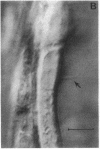Abstract
Previous studies have shown that the middle third of the rat inner medullary collecting duct (IMCD-2) secretes protons despite the absence of intercalated cells, the cell thought to secrete protons in other portions of the collecting duct. A new cell, the IMCD cell, is the predominant cell in IMCD-2. The mechanism responsible for base exit in the IMCD cell was characterized by measuring cell pH of isolated perfused tubules with 2',7'-bis(carboxyethyl)-5,6-carboxyfluorescein. Reduction of bath HCO3- caused a significant and reversible decrease in cell pH, whereas a similar change in luminal HCO3- had a significantly smaller effect, indicating that the HCO3-/H+ permeability of the basolateral membrane is much larger than the apical membrane. The rate of cell acidification induced by reduction in bath HCO3-, a measure of basolateral HCO3- transport, was significantly decreased in the absence of bath and lumen Cl. Decreases in bath Cl caused a significant and reversible increase in cell pH, which was not changed significantly by complete removal of Na from perfusate and bath, but was significantly inhibited by basolateral 4',5'-diisothiocyanostilbene-2,2'-disulfonic acid. A chemical voltage clamp did not inhibit the rate of cell alkalinization after bath Cl removal, indicating that Cl-/HCO3- exchange is not via parallel Cl and HCO3- conductances. Cell pH was measured in single cells by low-light-level imaging to show that most cells contain the chloride-dependent HCO3- pathway. We conclude that the rat IMCD cell possesses a basolateral Na-independent CL-/HCO3- exchanger which may serve as the base exit step for transepithelial proton secretion.
Full text
PDF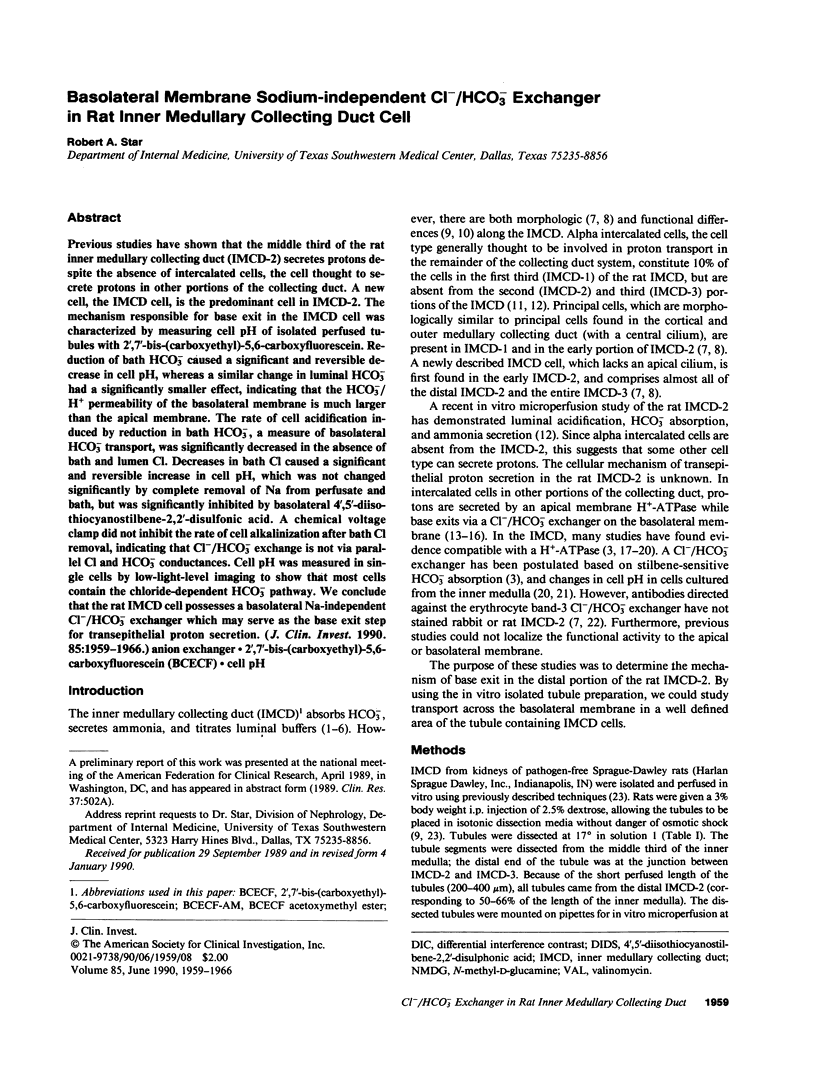
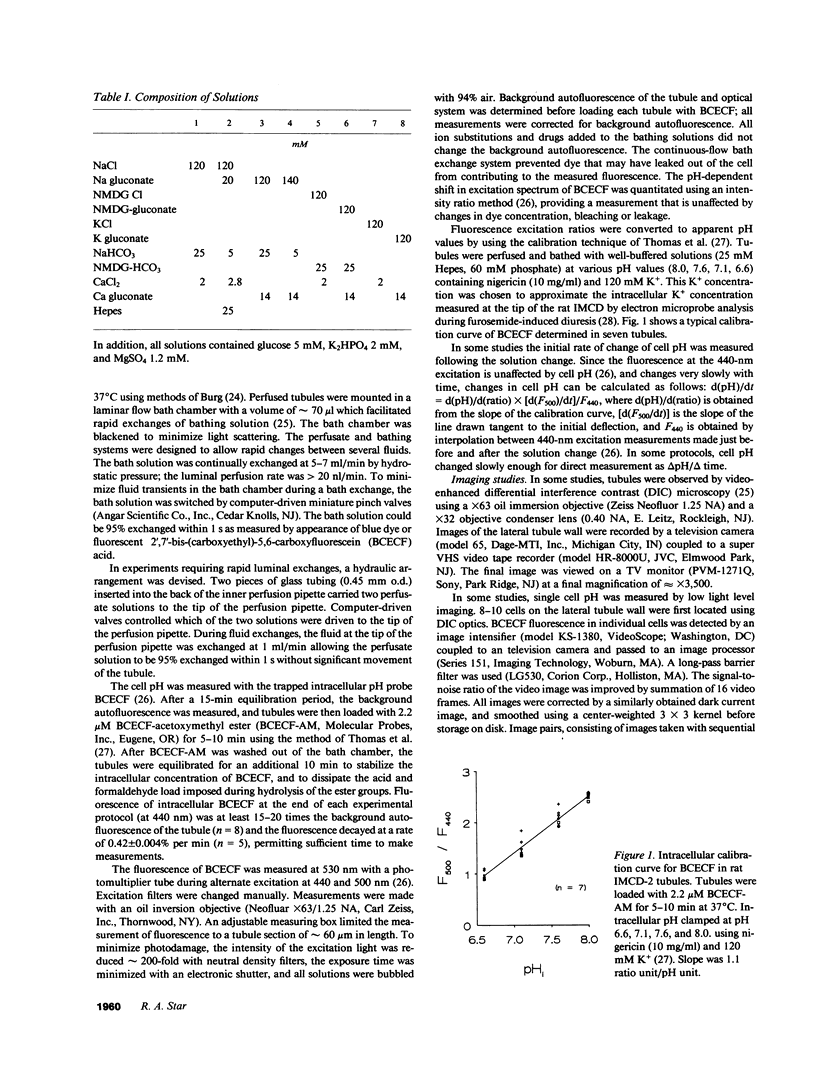
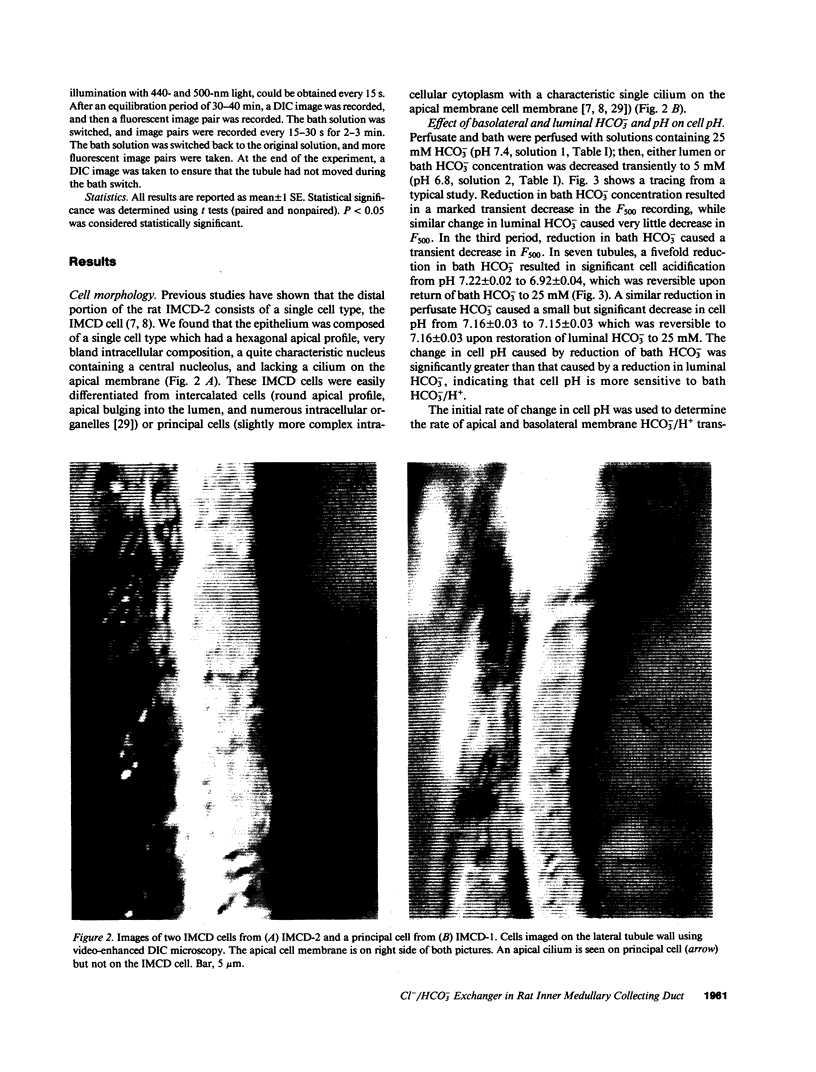

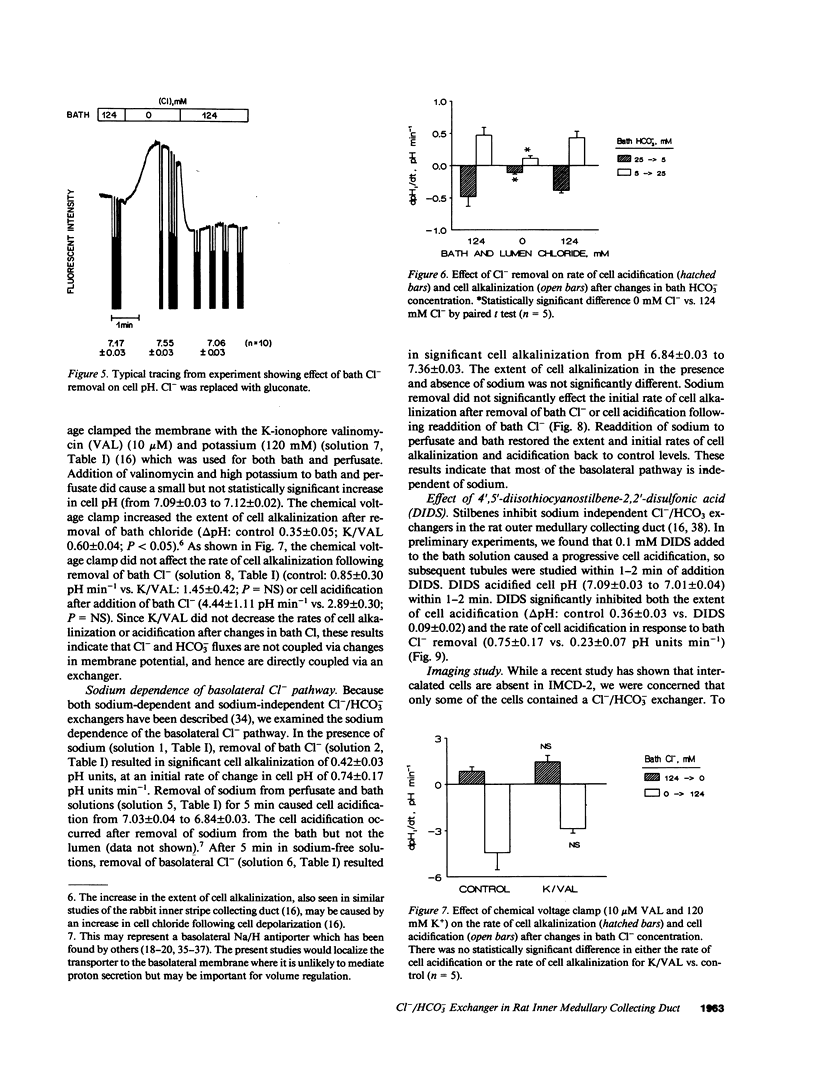



Images in this article
Selected References
These references are in PubMed. This may not be the complete list of references from this article.
- Alper S. L., Natale J., Gluck S., Lodish H. F., Brown D. Subtypes of intercalated cells in rat kidney collecting duct defined by antibodies against erythroid band 3 and renal vacuolar H+-ATPase. Proc Natl Acad Sci U S A. 1989 Jul;86(14):5429–5433. doi: 10.1073/pnas.86.14.5429. [DOI] [PMC free article] [PubMed] [Google Scholar]
- Alpern R. J., Chambers M. Cell pH in the rat proximal convoluted tubule. Regulation by luminal and peritubular pH and sodium concentration. J Clin Invest. 1986 Aug;78(2):502–510. doi: 10.1172/JCI112602. [DOI] [PMC free article] [PubMed] [Google Scholar]
- Alpern R. J. Mechanism of basolateral membrane H+/OH-/HCO-3 transport in the rat proximal convoluted tubule. A sodium-coupled electrogenic process. J Gen Physiol. 1985 Nov;86(5):613–636. doi: 10.1085/jgp.86.5.613. [DOI] [PMC free article] [PubMed] [Google Scholar]
- Beck F., Dörge A., Rick R., Thurau K. Osmoregulation of renal papillary cells. Pflugers Arch. 1985;405 (Suppl 1):S28–S32. doi: 10.1007/BF00581776. [DOI] [PubMed] [Google Scholar]
- Brion L. P., Schwartz J. H., Lachman H. M., Zavilowitz B. J., Schwartz G. J. Development of H+ secretion by cultured renal inner medullary collecting duct cells. Am J Physiol. 1989 Sep;257(3 Pt 2):F486–F501. doi: 10.1152/ajprenal.1989.257.3.F486. [DOI] [PubMed] [Google Scholar]
- Brown D., Hirsch S., Gluck S. Localization of a proton-pumping ATPase in rat kidney. J Clin Invest. 1988 Dec;82(6):2114–2126. doi: 10.1172/JCI113833. [DOI] [PMC free article] [PubMed] [Google Scholar]
- Burg M. B. Perfusion of isolated renal tubules. Yale J Biol Med. 1972 Jun-Aug;45(3-4):321–326. [PMC free article] [PubMed] [Google Scholar]
- Clapp W. L., Madsen K. M., Verlander J. W., Tisher C. C. Intercalated cells of the rat inner medullary collecting duct. Kidney Int. 1987 May;31(5):1080–1087. doi: 10.1038/ki.1987.111. [DOI] [PubMed] [Google Scholar]
- Clapp W. L., Madsen K. M., Verlander J. W., Tisher C. C. Morphologic heterogeneity along the rat inner medullary collecting duct. Lab Invest. 1989 Feb;60(2):219–230. [PubMed] [Google Scholar]
- DuBose T. D., Jr, Caflisch C. R. Effect of selective aldosterone deficiency on acidification in nephron segments of the rat inner medulla. J Clin Invest. 1988 Nov;82(5):1624–1632. doi: 10.1172/JCI113774. [DOI] [PMC free article] [PubMed] [Google Scholar]
- Garg L. C., Narang N. Stimulation of an N-ethylmaleimide-sensitive ATPase in the collecting duct segments of the rat nephron by metabolic acidosis. Can J Physiol Pharmacol. 1985 Oct;63(10):1291–1296. doi: 10.1139/y85-213. [DOI] [PubMed] [Google Scholar]
- Good D. W., Caflisch C. R., DuBose T. D., Jr Transepithelial ammonia concentration gradients in inner medulla of the rat. Am J Physiol. 1987 Mar;252(3 Pt 2):F491–F500. doi: 10.1152/ajprenal.1987.252.3.F491. [DOI] [PubMed] [Google Scholar]
- Hays S. R., Alpern R. J. Basolateral membrane Na(+)-independent Cl-/HCO3- exchange in the inner stripe of the rabbit outer medullary collecting tubule. J Gen Physiol. 1990 Feb;95(2):347–367. doi: 10.1085/jgp.95.2.347. [DOI] [PMC free article] [PubMed] [Google Scholar]
- Holthöfer H., Schulte B. A., Pasternack G., Siegel G. J., Spicer S. S. Three distinct cell populations in rat kidney collecting duct. Am J Physiol. 1987 Aug;253(2 Pt 1):C323–C328. doi: 10.1152/ajpcell.1987.253.2.C323. [DOI] [PubMed] [Google Scholar]
- Kleinman J. G., Blumenthal S. S., Wiessner J. H., Reetz K. L., Lewand D. L., Mandel N. S., Mandel G. S., Garancis J. C., Cragoe E. J., Jr Regulation of pH in rat papillary tubule cells in primary culture. J Clin Invest. 1987 Dec;80(6):1660–1669. doi: 10.1172/JCI113255. [DOI] [PMC free article] [PubMed] [Google Scholar]
- Koeppen B. M. Electrophysiology of collecting duct H+ secretion: effect of inhibitors. Am J Physiol. 1989 Jan;256(1 Pt 2):F79–F84. doi: 10.1152/ajprenal.1989.256.1.F79. [DOI] [PubMed] [Google Scholar]
- Krapf R., Alpern R. J., Rector F. C., Jr, Berry C. A. Basolateral membrane Na/base cotransport is dependent on CO2/HCO3 in the proximal convoluted tubule. J Gen Physiol. 1987 Dec;90(6):833–853. doi: 10.1085/jgp.90.6.833. [DOI] [PMC free article] [PubMed] [Google Scholar]
- Madsen K. M., Clapp W. L., Verlander J. W. Structure and function of the inner medullary collecting duct. Kidney Int. 1988 Oct;34(4):441–454. doi: 10.1038/ki.1988.201. [DOI] [PubMed] [Google Scholar]
- Mason M. J., Smith J. D., Garcia-Soto J. J., Grinstein S. Internal pH-sensitive site couples Cl-(-)HCO3- exchange to Na+-H+ antiport in lymphocytes. Am J Physiol. 1989 Feb;256(2 Pt 1):C428–C433. doi: 10.1152/ajpcell.1989.256.2.C428. [DOI] [PubMed] [Google Scholar]
- Muallem S., Blissard D., Cragoe E. J., Jr, Sachs G. Activation of the Na+/H+ and Cl-/HCO3- exchange by stimulation of acid secretion in the parietal cell. J Biol Chem. 1988 Oct 15;263(29):14703–14711. [PubMed] [Google Scholar]
- Preisig P. A., Alpern R. J. Basolateral membrane H-OH-HCO3 transport in the proximal tubule. Am J Physiol. 1989 May;256(5 Pt 2):F751–F765. doi: 10.1152/ajprenal.1989.256.5.F751. [DOI] [PubMed] [Google Scholar]
- Preisig P. A., Ives H. E., Cragoe E. J., Jr, Alpern R. J., Rector F. C., Jr Role of the Na+/H+ antiporter in rat proximal tubule bicarbonate absorption. J Clin Invest. 1987 Oct;80(4):970–978. doi: 10.1172/JCI113190. [DOI] [PMC free article] [PubMed] [Google Scholar]
- Richardson R. M., Kunau R. T., Jr Bicarbonate reabsorption in the papillary collecting duct: effect of acetazolamide. Am J Physiol. 1982 Jul;243(1):F74–F80. doi: 10.1152/ajprenal.1982.243.1.F74. [DOI] [PubMed] [Google Scholar]
- Sands J. M., Knepper M. A. Urea permeability of mammalian inner medullary collecting duct system and papillary surface epithelium. J Clin Invest. 1987 Jan;79(1):138–147. doi: 10.1172/JCI112774. [DOI] [PMC free article] [PubMed] [Google Scholar]
- Sands J. M., Nonoguchi H., Knepper M. A. Vasopressin effects on urea and H2O transport in inner medullary collecting duct subsegments. Am J Physiol. 1987 Nov;253(5 Pt 2):F823–F832. doi: 10.1152/ajprenal.1987.253.5.F823. [DOI] [PubMed] [Google Scholar]
- Schuster V. L., Bonsib S. M., Jennings M. L. Two types of collecting duct mitochondria-rich (intercalated) cells: lectin and band 3 cytochemistry. Am J Physiol. 1986 Sep;251(3 Pt 1):C347–C355. doi: 10.1152/ajpcell.1986.251.3.C347. [DOI] [PubMed] [Google Scholar]
- Schuster V. L., Stokes J. B. Chloride transport by the cortical and outer medullary collecting duct. Am J Physiol. 1987 Aug;253(2 Pt 2):F203–F212. doi: 10.1152/ajprenal.1987.253.2.F203. [DOI] [PubMed] [Google Scholar]
- Selvaggio A. M., Schwartz J. H., Bengele H. H., Gordon F. D., Alexander E. A. Mechanisms of H+ secretion by inner medullary collecting duct cells. Am J Physiol. 1988 Mar;254(3 Pt 2):F391–F400. doi: 10.1152/ajprenal.1988.254.3.F391. [DOI] [PubMed] [Google Scholar]
- Stanton B. A. Characterization of apical and basolateral membrane conductances of rat inner medullary collecting duct. Am J Physiol. 1989 May;256(5 Pt 2):F862–F868. doi: 10.1152/ajprenal.1989.256.5.F862. [DOI] [PubMed] [Google Scholar]
- Star R. A., Burg M. B., Knepper M. A. Bicarbonate secretion and chloride absorption by rabbit cortical collecting ducts. Role of chloride/bicarbonate exchange. J Clin Invest. 1985 Sep;76(3):1123–1130. doi: 10.1172/JCI112067. [DOI] [PMC free article] [PubMed] [Google Scholar]
- Star R. A., Nonoguchi H., Balaban R., Knepper M. A. Calcium and cyclic adenosine monophosphate as second messengers for vasopressin in the rat inner medullary collecting duct. J Clin Invest. 1988 Jun;81(6):1879–1888. doi: 10.1172/JCI113534. [DOI] [PMC free article] [PubMed] [Google Scholar]
- Strange K., Spring K. R. Cell membrane water permeability of rabbit cortical collecting duct. J Membr Biol. 1987;96(1):27–43. doi: 10.1007/BF01869332. [DOI] [PubMed] [Google Scholar]
- Strange K., Spring K. R. Methods for imaging renal tubule cells. Kidney Int. 1986 Aug;30(2):192–200. doi: 10.1038/ki.1986.171. [DOI] [PubMed] [Google Scholar]
- Sun A., Hebert S. C. Rapid hypertonic cell volume regulation in the perfused inner medullary collecting duct. Kidney Int. 1989 Nov;36(5):831–842. doi: 10.1038/ki.1989.269. [DOI] [PubMed] [Google Scholar]
- Teti A., Blair H. C., Teitelbaum S. L., Kahn A. J., Koziol C., Konsek J., Zambonin-Zallone A., Schlesinger P. H. Cytoplasmic pH regulation and chloride/bicarbonate exchange in avian osteoclasts. J Clin Invest. 1989 Jan;83(1):227–233. doi: 10.1172/JCI113863. [DOI] [PMC free article] [PubMed] [Google Scholar]
- Thomas J. A., Buchsbaum R. N., Zimniak A., Racker E. Intracellular pH measurements in Ehrlich ascites tumor cells utilizing spectroscopic probes generated in situ. Biochemistry. 1979 May 29;18(11):2210–2218. doi: 10.1021/bi00578a012. [DOI] [PubMed] [Google Scholar]
- ULLRICH K. J., EIGLER F. W. Sekretion von Wasserstoffionen in den Sammelrohren des Säugetierniere. Pflugers Arch. 1958;267(5):491–496. doi: 10.1007/BF00361735. [DOI] [PubMed] [Google Scholar]
- ULLRICH K. J., HILGER H. H., KLUMPER J. D. Sekretion von Ammoniumionen in den Sammelrohren der Säugetierniere. Pflugers Arch. 1958;267(3):244–250. doi: 10.1007/BF00362428. [DOI] [PubMed] [Google Scholar]
- Ullrich K. J., Papavassiliou F. Bicarbonate reabsorption in the papillary collecting duct of rats. Pflugers Arch. 1981 Mar;389(3):271–275. doi: 10.1007/BF00584789. [DOI] [PubMed] [Google Scholar]
- Verlander J. W., Madsen K. M., Low P. S., Allen D. P., Tisher C. C. Immunocytochemical localization of band 3 protein in the rat collecting duct. Am J Physiol. 1988 Jul;255(1 Pt 2):F115–F125. doi: 10.1152/ajprenal.1988.255.1.F115. [DOI] [PubMed] [Google Scholar]
- Wall S. M., Muallem S., Kraut J. A. Detection of a Na+-H+ antiporter in cultured rat renal papillary collecting duct cells. Am J Physiol. 1987 Nov;253(5 Pt 2):F889–F895. doi: 10.1152/ajprenal.1987.253.5.F889. [DOI] [PubMed] [Google Scholar]
- Wall S. M., Sands J. M., Flessner M. F., Nonoguchi H., Spring K. R., Knepper M. A. Net acid transport by isolated perfused inner medullary collecting ducts. Am J Physiol. 1990 Jan;258(1 Pt 2):F75–F84. doi: 10.1152/ajprenal.1990.258.1.F75. [DOI] [PubMed] [Google Scholar]




